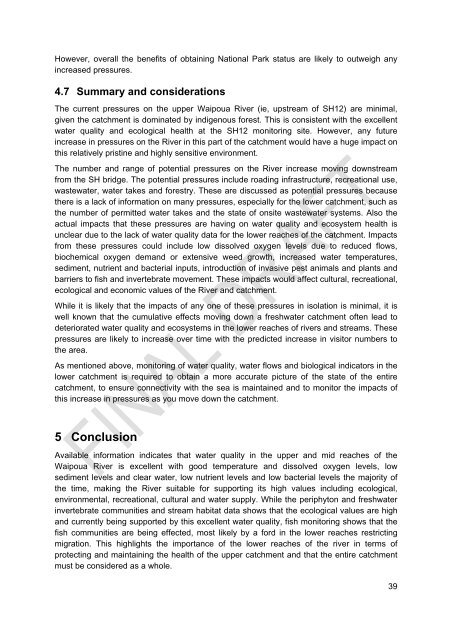Waipoua River 20130219.pdf - Northland Regional Council
Waipoua River 20130219.pdf - Northland Regional Council
Waipoua River 20130219.pdf - Northland Regional Council
- No tags were found...
You also want an ePaper? Increase the reach of your titles
YUMPU automatically turns print PDFs into web optimized ePapers that Google loves.
However, overall the benefits of obtaining National Park status are likely to outweigh anyincreased pressures.4.7 Summary and considerationsThe current pressures on the upper <strong>Waipoua</strong> <strong>River</strong> (ie, upstream of SH12) are minimal,given the catchment is dominated by indigenous forest. This is consistent with the excellentwater quality and ecological health at the SH12 monitoring site. However, any futureincrease in pressures on the <strong>River</strong> in this part of the catchment would have a huge impact onthis relatively pristine and highly sensitive environment.The number and range of potential pressures on the <strong>River</strong> increase moving downstreamfrom the SH bridge. The potential pressures include roading infrastructure, recreational use,wastewater, water takes and forestry. These are discussed as potential pressures becausethere is a lack of information on many pressures, especially for the lower catchment, such asthe number of permitted water takes and the state of onsite wastewater systems. Also theactual impacts that these pressures are having on water quality and ecosystem health isunclear due to the lack of water quality data for the lower reaches of the catchment. Impactsfrom these pressures could include low dissolved oxygen levels due to reduced flows,biochemical oxygen demand or extensive weed growth, increased water temperatures,sediment, nutrient and bacterial inputs, introduction of invasive pest animals and plants andbarriers to fish and invertebrate movement. These impacts would affect cultural, recreational,ecological and economic values of the <strong>River</strong> and catchment.While it is likely that the impacts of any one of these pressures in isolation is minimal, it iswell known that the cumulative effects moving down a freshwater catchment often lead todeteriorated water quality and ecosystems in the lower reaches of rivers and streams. Thesepressures are likely to increase over time with the predicted increase in visitor numbers tothe area.As mentioned above, monitoring of water quality, water flows and biological indicators in thelower catchment is required to obtain a more accurate picture of the state of the entirecatchment, to ensure connectivity with the sea is maintained and to monitor the impacts ofthis increase in pressures as you move down the catchment.5 ConclusionAvailable information indicates that water quality in the upper and mid reaches of the<strong>Waipoua</strong> <strong>River</strong> is excellent with good temperature and dissolved oxygen levels, lowsediment levels and clear water, low nutrient levels and low bacterial levels the majority ofthe time, making the <strong>River</strong> suitable for supporting its high values including ecological,environmental, recreational, cultural and water supply. While the periphyton and freshwaterinvertebrate communities and stream habitat data shows that the ecological values are highand currently being supported by this excellent water quality, fish monitoring shows that thefish communities are being effected, most likely by a ford in the lower reaches restrictingmigration. This highlights the importance of the lower reaches of the river in terms ofprotecting and maintaining the health of the upper catchment and that the entire catchmentmust be considered as a whole.39
















